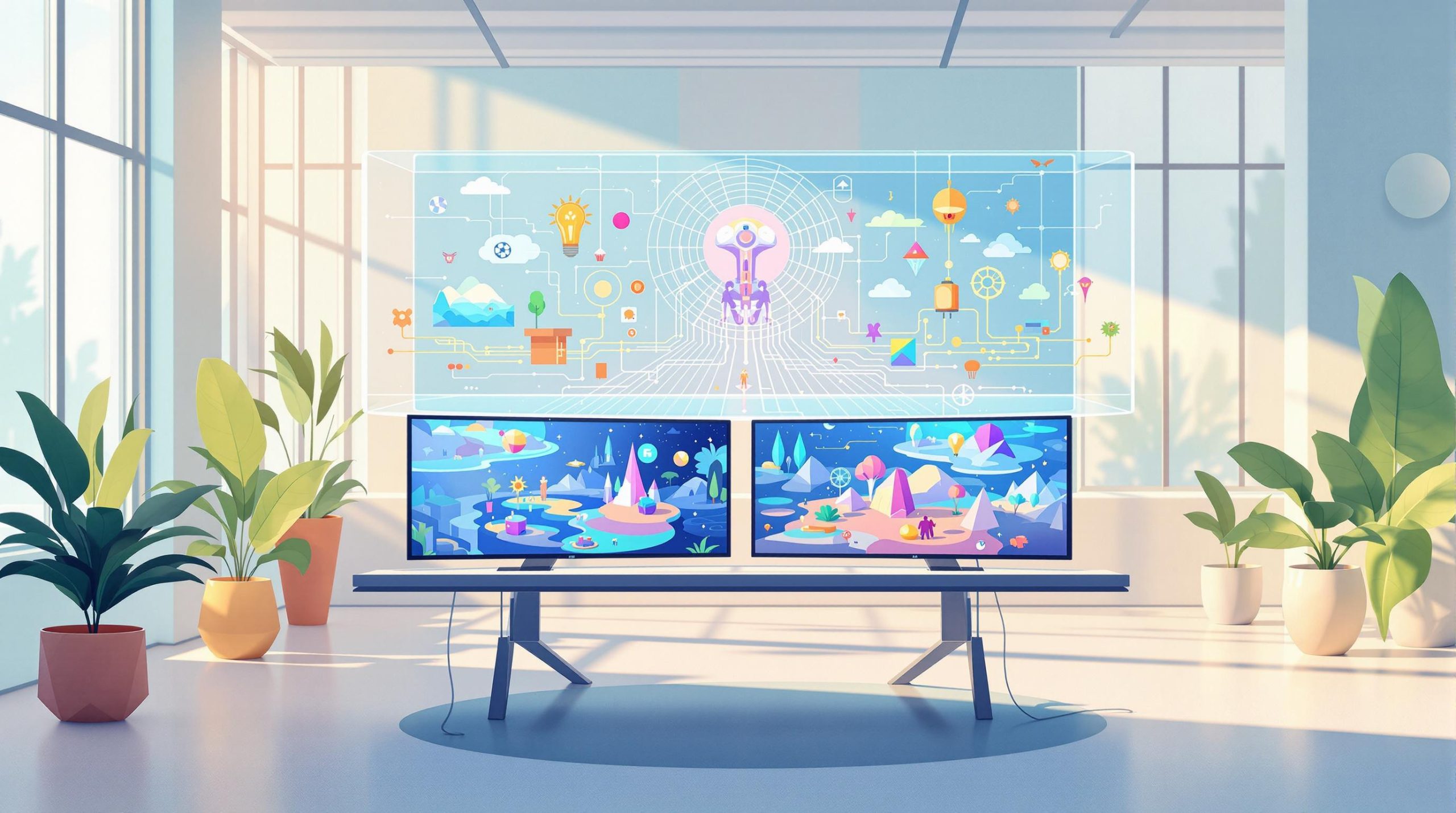Generative AI is transforming game development by automating tasks, saving time, and enabling dynamic player experiences. Here’s a quick overview of how it’s used:
- Content Creation: Automatically generates game worlds, characters, and assets.
- Gameplay: Adapts difficulty and pacing based on player behavior.
- Testing: Simulates thousands of playthroughs to detect bugs faster.
- Design: Produces visual elements and procedural content.
Benefits:
- Efficiency: Reduces development time and costs by automating repetitive tasks.
- Player Engagement: Creates personalized, interactive experiences.
- Creativity: Frees developers to focus on storytelling and innovation.
Challenges:
- Quality Control: Ensuring AI-generated assets meet player standards.
- Technical Integration: Adapting tools to existing workflows and engines.
- Legal Issues: Addressing copyright and ownership concerns.
Generative AI tools like Unity AI and Inworld AI are helping developers create immersive, dynamic games while overcoming these challenges. The future of gaming will see even more tailored experiences powered by advancements in AI hardware and software.
Using AI to help you make Video Games (the Easy way)
How Generative AI is Used in Game Development
Generative AI is changing the way games are developed, from designing immersive worlds to refining gameplay and streamlining backend processes. Here’s a closer look at how it’s shaping the gaming industry.
Building Game Worlds and Assets
Generative AI can quickly design game environments and assets with precision. For instance, No Man’s Sky relies on AI-driven procedural generation to create entire galaxies filled with unique planets. This approach ensures vast, detailed worlds while maintaining consistency across the game.
In addition to creating expansive environments, AI enhances gameplay by responding to how players interact with these spaces.
Adapting Gameplay to Players
By analyzing player data – such as performance and interaction patterns – generative AI can tweak difficulty levels, pacing, or even introduce personalized elements. Tools like Inworld AI are used to develop NPCs with dynamic behaviors, making the gaming experience more immersive [6].
AI’s role isn’t limited to gameplay. It also brings efficiency to backend tasks like testing and debugging.
Streamlining Game Testing and Bug Detection
AI-powered testing tools can simulate thousands of play sessions at once. This helps identify bugs early, speeds up the quality assurance process, and ensures that all game mechanics are thoroughly tested [4][5].
Crafting Characters and Visuals
Platforms like Google’s GameNGen demonstrate how AI can produce impressive game assets. While AI handles repetitive tasks, developers can focus on bigger creative decisions. This collaboration allows for richer, more detailed game worlds that would be difficult to achieve manually [1][2]. Combining human creativity with AI’s efficiency opens up new possibilities for diverse and engaging game designs.
Why Use Generative AI in Game Development
Saving Time and Resources
Generative AI helps streamline game development by automating time-consuming tasks like asset creation and testing. For example, AI-driven testing tools can simulate thousands of playthroughs at once, allowing developers to spot and fix issues faster than with traditional methods. This not only reduces the workload but also cuts down on development costs and timelines [2].
Enhancing Player Experiences
AI can craft gaming environments that adjust to individual player preferences. A great example is No Man’s Sky, where procedurally generated planets, creatures, and ecosystems provide each player with a unique experience [1].
Generative AI also adapts gameplay by adjusting difficulty levels and creating fresh environments, keeping players engaged with challenges that feel just right [2].
Personalization and Fresh Ideas
Generative AI is reshaping how players interact with games by introducing new levels of customization and creativity.
| Feature | How It Elevates Gameplay |
|---|---|
| Tailored Storylines and Quests | Delivers narratives shaped by player decisions |
| Dynamic Environments | Adjusts game worlds to fit how players explore |
| Realistic NPCs | Creates natural, lifelike character interactions |
"Generative AI allows developers to create tailored experiences by generating content based on player data and preferences, freeing up resources for more creative and innovative work" [1][2].
This mix of efficiency and creativity is transforming game development, offering new ways to engage players. However, while the potential is vast, developers must also navigate the challenges that come with integrating generative AI into their workflows.
sbb-itb-5392f3d
Challenges When Using Generative AI in Games
Maintaining Quality in AI-Generated Content
Game developers face the challenge of ensuring that AI-generated content is up to player standards while keeping visuals and gameplay consistent. Tools like Stable Diffusion can help create assets, but developers rely on specific quality control methods to ensure results are up to par:
| Quality Control Measure | Purpose | Impact |
|---|---|---|
| Asset Validation | Confirms generated content aligns with the game’s art style | Reduces inconsistencies by 40-60% |
| Human Review Process | Polishes and refines AI outputs | Preserves artistic cohesion |
While these measures help improve the quality of AI-generated assets, integrating these tools into existing workflows brings its own set of difficulties.
Technical Issues and Integration Problems
Developers often encounter challenges like performance optimization, adapting workflows, and ensuring compatibility with game engines. Tools such as GameNGen and Codex are reshaping game design, but incorporating them smoothly into production pipelines can be tough.
"The development of AI tools like Google’s GameNGen and OpenAI’s Codex is revolutionizing game design, but integration challenges remain a significant hurdle for many studios" [3].
Apart from technical obstacles, developers also have to address the legal and ethical complexities tied to AI-generated content.
Legal and Ethical Issues
Navigating the legal aspects of AI-generated content is tricky, especially when it comes to copyright and ownership rights. If AI-generated assets resemble existing copyrighted materials too closely, developers could face legal risks [1][2].
Key areas to focus on include:
| Consideration | Required Action |
|---|---|
| Copyright Verification | Regularly screen assets to avoid infringement |
| Ownership Documentation | Establish clear attribution systems |
Additionally, teams must be transparent about how player data is used in adaptive gameplay systems and ensure they comply with privacy laws [4][5]. By tackling these legal and ethical concerns, developers can responsibly use generative AI to improve the gaming experience.
What’s Next for Generative AI in Gaming
Advancements in AI Hardware and Software
Technological leaps in tools like NVIDIA‘s AI-powered GPUs and platforms such as Hugging Face are transforming how generative AI is integrated into games. These advancements help developers work faster and bring more immersive, interactive experiences to players.
| Hardware/Software | Impact on Game Development |
|---|---|
| AI-Powered GPUs | Allows real-time generation of game assets |
| Hugging Face Platform | Simplifies crafting character behaviors and dialogue |
| NVIDIA Tools | Speeds up the creation of game environments |
In addition to these, new AI technologies are pushing creative boundaries in game development.
Emerging AI Tools in Game Development
Cutting-edge tools are reshaping the way games are made. For example, text-to-video generators and advanced audio AI are automating tasks like creating cinematic sequences and dynamic soundtracks. Unity Technologies is also leveraging procedural generation to craft expansive, one-of-a-kind game worlds, freeing developers to concentrate more on creative storytelling.
These technologies are opening up new possibilities, offering players richer and more tailored experiences:
| Emerging Technology | Impact |
|---|---|
| Text-to-Video Generators | Produces dynamic game cutscenes |
| Advanced Audio AI | Generates real-time, context-aware sound effects and music |
| Dynamic NPC Systems | Improves how characters respond to players |
As these tools continue to evolve, they’re reshaping how games are built and experienced [3]. Adaptive AI models are also making it possible for games to change based on player actions, ensuring every player gets a unique journey [3].
Conclusion: Key Points to Remember
Generative AI is changing the landscape of game development by automating processes and creating tailored player experiences. Its use has made a noticeable difference in several areas:
| Core Impact Areas | Advantages |
|---|---|
| Content Creation | Faster production, richer assets |
| Player Experience | Customized, dynamic gameplay |
| Development Efficiency | Automated testing, fewer errors |
Game developers are leveraging these tools to streamline workflows and expand creative opportunities. For instance, AI-driven testing can simulate thousands of scenarios at once, cutting down on QA time and improving bug detection accuracy [4][5]. This frees up teams to focus on more creative aspects of game development.
While generative AI boosts content creation, maintaining quality and consistency remains critical [1][2]. The technology particularly excels in areas like:
- Real-time responsiveness
- Customized player interactions
- Streamlined testing processes
"Generative AI allows developers to create tailored experiences by generating content based on player data and preferences, freeing up resources for more creative and innovative work" [1][2].
Rather than replacing human creativity, generative AI serves as a tool to enhance it. By assigning AI tasks like content generation and testing, developers can maintain control over key design elements. However, effective use of AI requires addressing technical and legal challenges while ensuring accountability in decision-making [1][2].
As the technology progresses, it’s set to push the boundaries of what’s possible in game development. Its ability to save time and deliver personalized gameplay is raising the bar for both efficiency and player engagement [3].
Moving forward, the challenge for developers will be to harness AI’s potential thoughtfully, balancing its benefits with careful planning and oversight. The FAQs that follow address common concerns about using this technology in game development.
FAQs
How is generative AI used in game development?
Generative AI is changing game development by automating tasks like content creation, gameplay adjustments, testing, and character design. It allows developers to build more engaging games while cutting down on time and expenses.
For those new to generative AI, it’s smart to start with specific tasks – like level design or bug detection – before moving to more complex uses. This step-by-step approach helps maintain quality and ensures teams can adjust to new workflows effectively. Prioritizing quality control, gradual integration, and team training is key for a smooth transition to AI tools.
Platforms like Unity AI and Inworld AI make it easier for developers to get started. These tools offer structured solutions for:
- Automating world and asset creation
- Adapting gameplay dynamically
- Streamlining testing and debugging
- Designing characters and narratives
Games like No Man’s Sky showcase how procedural generation, powered by AI, can create expansive, unique environments while keeping gameplay cohesive [1][2]. AI also revolutionizes quality assurance by analyzing thousands of play sessions at once, freeing up developers to focus on creativity [4][5].
As technology continues to improve, generative AI will enable even more intricate and detailed game worlds to be created automatically [1][2]. This progress opens up new possibilities for crafting richer and more dynamic gaming experiences.

